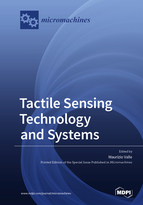Tactile Sensing Technology and Systems
A special issue of Micromachines (ISSN 2072-666X). This special issue belongs to the section "A:Physics".
Deadline for manuscript submissions: closed (31 August 2019) | Viewed by 32508
Special Issue Editor
Interests: electronic/artificial sensitive skin; tactile sensing systems for prosthetics and robotics; electronic embedded systems; internet of things; microelectronics and nanoelectronics
Special Issues, Collections and Topics in MDPI journals
Special Issue Information
Dear Colleagues,
Tactile sensors acquire tactile information through physical touch; measurands are, for example, temperature, vibration, softness, texture, shape, composition and shear and normal forces. Electronic/artificial skin comprises embedded electronic systems which integrate tactile sensing arrays, signal acquisition, data processing and decoding, and can transmit collated information. Such electronic/artificial skin will become one of the main sensing essentials in prosthetics, bionics, robotics, virtual reality, haptic devices, IoT, etc.
Tactile sensors are basically distributed sensors which translate mechanical and physical variables and pain stimuli into electrical variables. Contact information is further processed and conveyed to a supervising system. Tactile arrays ought to be mechanically flexible (i.e., conformable to the object it is applied to) and stretchable and tactile information decoding must be implemented in real time. The development of artificial tactile sensing is a big challenge as it involves numerous research areas. Application domains include humanoid and industrial robotics, prosthetics, biomedical instrumentation, health care, cyber physical systems, virtual reality, arts, to name but a few.
Recent and relevant achievements in materials and transducers have not yet successfully boosted system developments due to the challenging gaps which still need to be filled at many levels, e.g. data decoding and processing, miniaturization, mechanical compliance, robustness, among others. Tactile sensing has developed rapidly over the past three decades, but has yet to achieve high impact breakthroughs in application domains.
In this Special Issue, we focus on both insights and advancements in tactile sensing with the goal of bridging different research areas, e.g., material science, electronics, robotics, neuroscience, mechanics, sensors, MEMS/NEMS, addictive and 3D manufacturing, bio and neuro-engineering.
We would like to receive commentaries, perspectives and insightful reviews on related topics as well as technological breakthroughs of original works, civil and industrial applications in both short communications and full papers.
Prof. Maurizio Valle
Guest Editor
Manuscript Submission Information
Manuscripts should be submitted online at www.mdpi.com by registering and logging in to this website. Once you are registered, click here to go to the submission form. Manuscripts can be submitted until the deadline. All submissions that pass pre-check are peer-reviewed. Accepted papers will be published continuously in the journal (as soon as accepted) and will be listed together on the special issue website. Research articles, review articles as well as short communications are invited. For planned papers, a title and short abstract (about 100 words) can be sent to the Editorial Office for announcement on this website.
Submitted manuscripts should not have been published previously, nor be under consideration for publication elsewhere (except conference proceedings papers). All manuscripts are thoroughly refereed through a single-blind peer-review process. A guide for authors and other relevant information for submission of manuscripts is available on the Instructions for Authors page. Micromachines is an international peer-reviewed open access monthly journal published by MDPI.
Please visit the Instructions for Authors page before submitting a manuscript. The Article Processing Charge (APC) for publication in this open access journal is 2600 CHF (Swiss Francs). Submitted papers should be well formatted and use good English. Authors may use MDPI's English editing service prior to publication or during author revisions.
Keywords
- Innovative structural and sensing materials
- Manufacturing technology
- Additive and 3D manufacturing
- Novel tactile sensors
- Flexible, conformable and stretchable sensors and arrays
- Electronic interface
- Artificial and electronic skin
- Tactile data processing and interpretation
- Innovative applications
- Haptic devices
- Touch-based human–robot interaction
- Tactile and visual sensing integration
- Tactile Internet
- Tactile sensing in prosthetics, neuro-rehabilitation, neuro and bio engineering, consumer goods, arts, IoT







